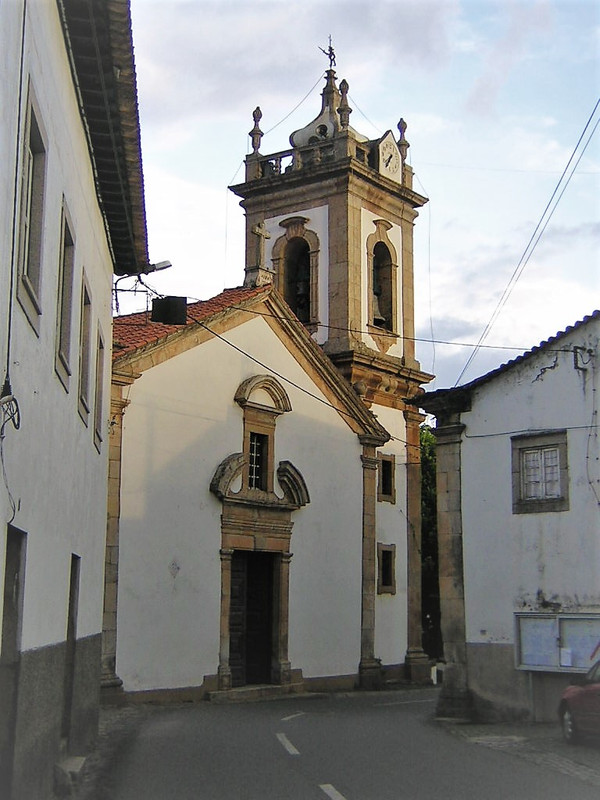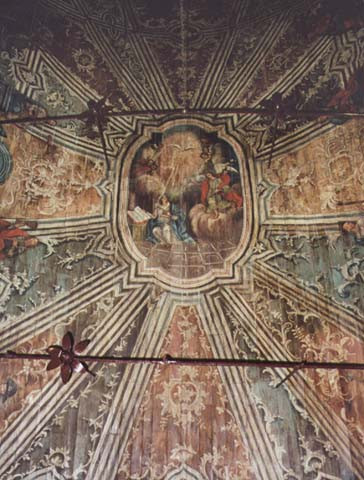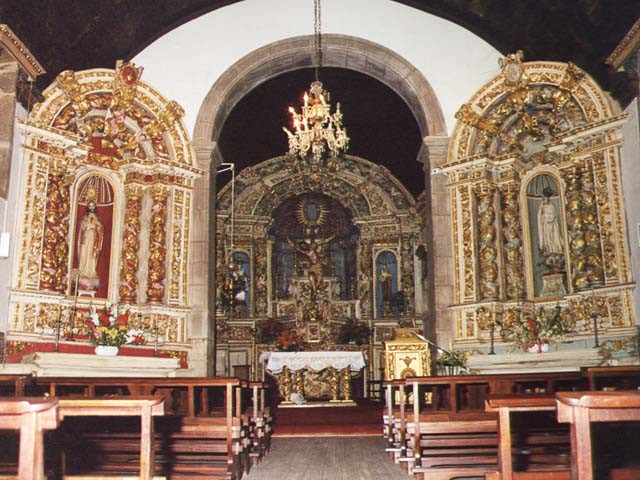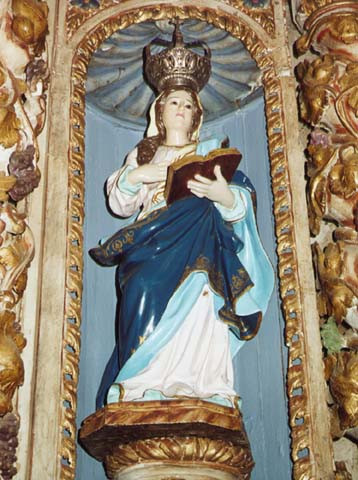[PT]
Igreja Matriz do Paul - Igreja de Nossa Senhora da Anunciação
José Saramago, na sua “Viagem a Portugal”, referiu-se a Paul, em especial à igreja matriz: “Paul tem para mostrar, em pontos de arte, o tecto pintado da igreja matriz. É um trompe l’oeil convencional, como costuma sê-lo este género de pintura, mas vir encontra-lo aqui, no coração da Beira, é tão insólito como o encontro surrealista da máquina de costura e do guarda-chuva na mesa de anatomia. Estes raptos de falsas arquitecturas usam-se em palácios, não em modestas igrejas, como esta, onde neste momento uma catequista apascenta uma molhada de crianças, que vão de estação em estação, dizendo as orações da circunstância (…)”.
Dos seus altares destacam-se três em talha dourada com fino ornamento, assim como belas imagens da liturgia cristã.
A igreja matriz com características barrocas, apresenta o seu interior riquíssimo, possuído um apainelamento, com belo espécimen da pintura de arte italiana, invocando Nossa Senhora da Anunciação, orago da mesma igreja e paroquia. É considerada por especialistas o maior quadro pintado existente em Portugal e um dos maiores da Europa. Dos seus cinco altares evidenciam-se três em bela talha dourada com fino ornamento, assim como as belas e antigas imagens da liturgia cristã.
Fontes: Anafre e Câmara Municipal da Covilhã
A Igreja Matriz do Paul ou Igreja de Nossa Senhora da Anunciação, foi em 2014 classificada como monumento de interesse público (portaria Nº550/2014 - DR 2ªSérie Nº127 de 4 de Julho de 2014), curiosamente, aquando da publicação da portaria esta refere-se erroneamente à igreja como Igreja de Nossa Senhora da Assunção.
Acredita-se ter sido construída em finais do século XVII ou inicio século XVIII, no topo da fachada principal encontra-se uma cruz em pedra de granito (e de difícil visualização) com a data de 1719? na sua base, é acompanhada por uma única torre sineira encrostada com o tradicional relógio.
Adjacente à igreja situa-se o salão paroquial dividido em auditório/sala de espetáculos e sala de reuniões. Este espaço multiusos é palco usual das festas de natal ou outras ligadas às valências do Centro Paroquial de Nossa Senhora das Dores. É também local de reuniões de catequese.

A real beleza deste monumento inserido no Largo da Praça (ou Conde do Refugio) prende-se no seu interior, um monumental quadro-tecto abobadado de pintura italiana, preenche toda a zona da nave e do coro alto. Inspirado no tema da Anunciação do Anjo Gabriel a Maria em destaque na zona central, estão também representados apóstolos e doutores da Igreja simbolicamente retratados junto a pilares.
Encontram-se ainda presentes 5 altares, compondo o altar-mor uma estátua em tamanho real de Jesus Crucificado ao centro acompanhado nas laterais por São José e Nossa Senhora da Anunciação (Padroeira da paroquia) formando assim a Sagrada Família. Dois altares secundários também em talha dourada acomodam estátuas de Nossa Senhora de Fátima e do Sagrado Coração de Jesus. Finalmente, os dois altares menores nas laterais da nave, um deles retrata o momento da crucificação no monte do calvário com Jesus Crucificado, Maria Madalena e São João, o outro possui imagens de São Sebastião e Menino Jesus de Praga.
Como em tantas outras igrejas, na lateral da entrada principal encontra-se a pia batismal construída em pedra de granito. Imediatamente à frente da Igreja encontra-se a Casa Paroquia, residência do parco do Paul.

[EN]
Mother Church of Paul - Church of Our Lady of the Annunciation
José Saramago, in his "Viajem a Portugal", referred to Paul, especially to the main church: "Paul has to show, in points of art, the painted ceiling of the main church. It's a conventional trompe l'oeil, as this genre of painting is, but to find it here in the heart of Beira is as unusual as the surrealist meeting of the sewing machine and the umbrella on the table of anatomy . These abductions of false architectures are used in palaces, not in modest churches, like this one (...)".
Of its altars stand three in gilded carving with fine ornament, as well as beautiful images of the Christian liturgy.
The mother church with Baroque features, presents its rich interior, possessed a paneling, with beautiful specimen of Italian art painting, invoking Our Lady of the Annunciation, oracle of the same church and parish. It is considered by specialists the largest painted painting existing in Portugal and one of the largest in Europe. From its five altars stand out three in fine golden carving with fine ornament, as well as the beautiful and ancient images of the Christian liturgy.
Sources: Anafre and Covilhã Town Hall
The Mother Church of Paul or Church of Our Lady of the Annunciation was in 2014 classified as a monument of public interest (Ordinance No. 550/2014 - DR 2ª Series No. 127 of July 4, 2014), curiously, on the publication of the ordinance this refers Erroneously to the church as Church of Our Lady of the Assumption.
It is believed to have been built in the late seventeenth or early eighteenth century, at the top of the main façade is a cross in granite stone (and difficult to see) dating to 1719? At its base, is accompanied by a unique bell tower crushed with the traditional clock.
Adjacent to the church is the parish hall divided into an auditorium / show room and meeting room. This multipurpose space is the usual stage of Christmas celebrations or others linked to the valences of the Parish Center of Our Lady of Sorrows. It is also a place for catechesis meetings.
The real beauty of this monument in Largo da Praça (or Conde do Refugio) is inside, a monumental vaulted ceiling of Italian painting, fills the whole area of the nave and the high choir. Inspired by the theme of the Annunciation of the Angel Gabriel to Mary highlighted in the central zone, there are also represented apostles and doctors of the Church symbolically portrayed along pillars.

There are also five altars, the main altar consisting of a life-size statue of Jesus Crucified at the center accompanied on the sides by St. Joseph and Our Lady of the Annunciation (Patron of the parish) thus forming the Holy Family. Two secondary altars also in gilded carving accommodate statues of Our Lady of Fatima and the Sacred Heart of Jesus. Finally, the two smaller altars on the sides of the nave, one depicting the moment of the crucifixion on the Calvary Hill with Jesus Crucified, Mary Magdalene and St. John, the other features images of St. Sebastian and the Child Jesus of Prague.
As in so many other churches, on the side of the main entrance is the baptismal font built of granite stone. Immediately in front of the Church is the Parish House, residence of Paul's priest.
